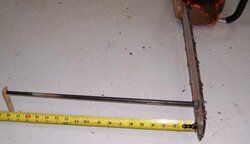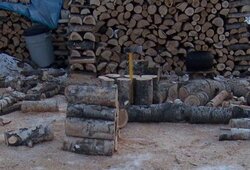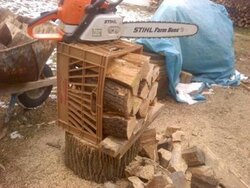This is a spin-off from this thread...Marking Logs for Length. I didn't want to hijack that thread as it's a good one on how folks are physically marking their log lengths for bucking. This post is more of a thought on why it matters to get more precise lengths of firewood.....
It seems to me that folks with smaller stoves would be more interested in precision in attaining their desired wood lengths for at least a couple of reasons.
The first reason being, naturally, so that the split will physically fit into the stove...simple enough.
(The following math used is a variant (deviant) of wood math processed in yours truly's gray matter, so caution henceforth is recommended...)
The second reason that is in my head is a little more involved.... With a small stove the operator will be challenged to get the most heat and longest burn that he can get. Struggling to get an overnight burn with a 1.1cf firebox is a lot diffferent than getting an overnight burn in a 2.4cf firebox. As much of the firebox as possible would need to be filled for the smaller stove to have a chance at an overnight burn whereas the larger stove should still easily get an overnight burn even if it's firebox usage isn't maximized. Both fireboxes can easily be filled in depth and height but it seems at the ends of the wood (sides of firebox) is where space is often wasted by "short" splits.
If the best length for a small stove is 16" then cutting wood sporadically and ending up with a lot of 14" stuff is going to affect the heat output and burn time by leaving a lot of empty space at the ends of the wood. A full load (depth and height filled) with 1/2 load of 16" splits and 1/2 load of 14" splits would be end up being (very) roughly 7.5% less fuel than a full load of all 16" splits. So (simple minded as I am) if we have a small stove that has a burn time of 5 hours with a full load of 16" splits then if we loaded a half-half mix of 14" and 16" splits the burn time would be shortened to roughly 4.6 hours...a 24 minute burn time penalty.
Another way of looking at this would be to figure that at a 5 hour burn time of 16" wood then we're averaging 3.2 inches per hour of wood (full firebox...depth & height). For each inch of wood length we add to a consistent 16" load we would be adding roughly 20 minutes of burn time.
Naturally odd shaped unglies, crotches, knots, punky wood, old tires, etc, will affect burn times.
Anyhow, just some rambling noises in my head this morning...
Ed
(ok you wood-burning gurus, straighten my errors out for me )
)
It seems to me that folks with smaller stoves would be more interested in precision in attaining their desired wood lengths for at least a couple of reasons.
The first reason being, naturally, so that the split will physically fit into the stove...simple enough.
(The following math used is a variant (deviant) of wood math processed in yours truly's gray matter, so caution henceforth is recommended...)
The second reason that is in my head is a little more involved.... With a small stove the operator will be challenged to get the most heat and longest burn that he can get. Struggling to get an overnight burn with a 1.1cf firebox is a lot diffferent than getting an overnight burn in a 2.4cf firebox. As much of the firebox as possible would need to be filled for the smaller stove to have a chance at an overnight burn whereas the larger stove should still easily get an overnight burn even if it's firebox usage isn't maximized. Both fireboxes can easily be filled in depth and height but it seems at the ends of the wood (sides of firebox) is where space is often wasted by "short" splits.
If the best length for a small stove is 16" then cutting wood sporadically and ending up with a lot of 14" stuff is going to affect the heat output and burn time by leaving a lot of empty space at the ends of the wood. A full load (depth and height filled) with 1/2 load of 16" splits and 1/2 load of 14" splits would be end up being (very) roughly 7.5% less fuel than a full load of all 16" splits. So (simple minded as I am) if we have a small stove that has a burn time of 5 hours with a full load of 16" splits then if we loaded a half-half mix of 14" and 16" splits the burn time would be shortened to roughly 4.6 hours...a 24 minute burn time penalty.
Another way of looking at this would be to figure that at a 5 hour burn time of 16" wood then we're averaging 3.2 inches per hour of wood (full firebox...depth & height). For each inch of wood length we add to a consistent 16" load we would be adding roughly 20 minutes of burn time.
Naturally odd shaped unglies, crotches, knots, punky wood, old tires, etc, will affect burn times.
Anyhow, just some rambling noises in my head this morning...
Ed
(ok you wood-burning gurus, straighten my errors out for me
 )
)





